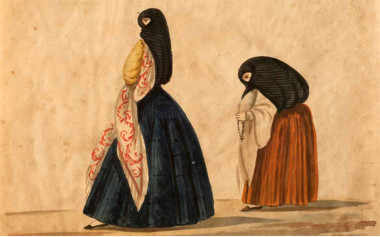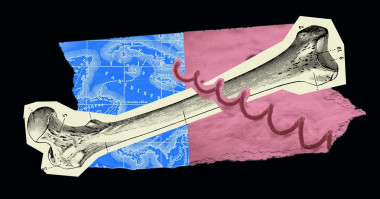two lovely kbin magazines on history (kbin.social)
currently, there are two different kbin magazines (=groups/communities) on history which slightly differ in their scraping habits:...

This magazine is from a federated server and may be incomplete. Browse more on the original instance.
currently, there are two different kbin magazines (=groups/communities) on history which slightly differ in their scraping habits:...

A vividly painted tomb dating to the 4th century B.C. has been unearthed in an ancient necropolis in Pontecagnano, near Salerno in the Campania region of southwest Italy.
In 1973, Egyptian soldiers hoisted their flag over Sinai, smashing the myth of Israeli invincibility. Fifty years on, who claims the victory?

Agriculture in Syria started with a bang 12,800 years ago as a fragmented comet slammed into the Earth's atmosphere. The explosion and subsequent environmental changes forced hunter-gatherers in the prehistoric settlement of Abu Hureyra to adopt agricultural practices to boost their chances for survival.

There are a significant number of Anglo-Saxon burials where the estimated anatomical sex of the skeleton does not align with the gender implied by the items they were buried with.

He was pardoned in 1781 after a letter was written arguing that, as a slave, he was not a citizen and thus could not commit treason against a government to which he owed no allegiance.
A rare 16th century globe has been restored and put on display at the Museo Galileo in Florence. The terrestrial globe was made by Antwerp cartographer Cornelis De Jode in 1594. Most of his surviving oeuvre is a world atlas, the Speculum Orbis Terrae, he published in 1593.
Once, a long time ago, there was a poet and a warrior. His name was Grette the Strong (Grettir Ásmundarson, an Icelandic outlaw). His superpower was widely known even among the strongest berserkers.

Life-size carvings of camels have been found in the Saudi Arabian desert, but archaeologists aren't sure who created them and when.

Journalist and activist Kirill Teiter became its first monarch. The following year, the error was corrected and Torgu officially became part of Estonia. Nevertheless, the kingdom's flag and coat of arms can still be seen in the parish.

The prosperous civilization of the Minoans represented one of the oldest cultures of the Bronze Age in the Mediterranean area and the first major Aegean civilization comparable in its achievements to the older ones, such as Egypt, Mesopotamia, and Anatolia.

Rumors and disinformation sparked the Kanto Massacre in the wake of the Kanto Earthquake. Today, denialism continues to dishonor the victims.

“In an era where the term “burka” evokes images of oppressive regimes, notably Afghanistan's coercive imposition on women, it may come as a surprise that the tapada limeña (meaning “the covered one from Lima”) was used as a cloak of female resistance to authority by the women of Lima for over three hundred years…....

Christopher Columbus was blamed for bringing syphilis to Europe. New DNA evidence suggests it was already there. Maybe both stories are true.

The Great Lakes' frigid fresh water used to keep shipwrecks so well preserved that divers could see dishes in the cupboards. Downed planes that spent decades underwater were left so pristine they could practically fly again when archaeologists finally discovered them.

In 1873, greed, speculation and overinvestment in railroads sparked a financial crisis that sank the U.S. into more than five years of misery
Letter from church source in anti-Hitler resistance reporting 6,000 daily killings undercuts Vatican’s claims of lack of knowledge



Approximately every 80 years, a faint 10th magnitude star in the constellation of Corona Borealis dramatically increases its brightness. This star, T CrB, is known as a recurrent nova and last flared in 1946, peaking at magnitude 2.0, temporarily making it one of the 50 brightest stars in the night sky.

Archeologists from Secrets of the Ice, a glacial archaeology program of Norway’s Department of Cultural Heritage, have discovered a Stone Age arrow shaft on the side of Mount Lauvhøe in Norway. The group surveyed the melting ice on Mount Lauvhøe in 2017 and found a number of Iron Age arrows, but the oldest were around 1,700...
Archaeologists using ground-penetrating radar report detecting huge ancient structures beneath the 3,000-year-old Zerzevan Castle in Turkey. Have scientists discovered an enormous ancient underground city or something else?

Symbols played a vital role and had incredible, meaningful power in the Celtic life. They reflected Celtic beliefs, traditions and were carried on from generation to generation.

A treasure hailed as the “gold find of the century in Norway” has been discovered by a metal detectorist in Rennesøy, an island in southwestern Norway. The group of gold bracteates and beads dates to the late Migration Period (375-568 A.D.), and is believed to have been part of a single opulent necklace.
How ancient was ancient Egypt? How old is the world? And what happens when archaeology contradicts the Bible? When the Dendera Zodiac arrived in Paris, these questions exploded into the public sphere.
